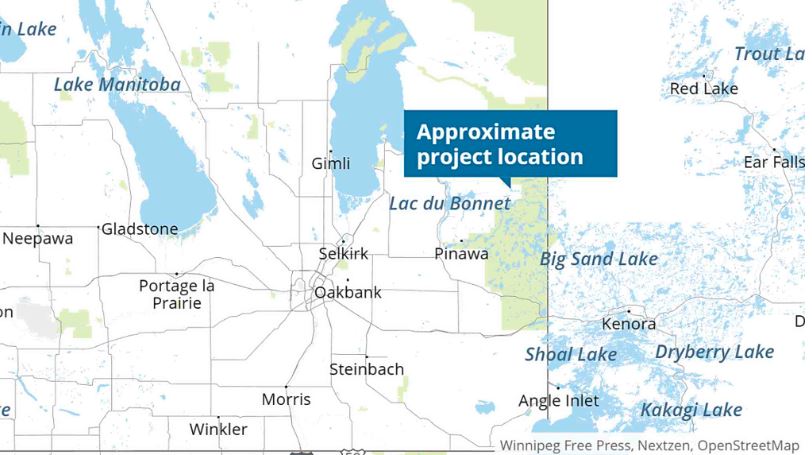Sagkeeng First Nation has struck a bold new agreement that paves the way for the largest lithium exploration project in the province.
Vancouver-based New Age Metals (NAM) will conduct exploratory drilling on traditional Sagkeeng territory near Bird River after agreeing to a contract that includes a commitment to revenue-sharing should ore be found.
"It's a protocol agreement for them to do exploration. It's not a free-for-all where they can do anything they want," said Sagkeeng Chief Derrick Henderson.
That was paramount to the Sagkeeng leader, who was assisted by a Toronto lawyer who specializes in contracts between first nations and mining companies. New Age paid the legal costs.
The agreement even calls on New Age to make a small payment to Sagkeeng amounting to from two-to-three per cent of what it spends on exploration. That may work out to an estimated $10,000 to $15,000 the first year.
"Sometimes we don't benefit when things happen in our territory. We get nothing," said Chief Henderson.
The agreement requires New Age to mitigate environmental impact where possible. For example, it must perform an archaeological study prior to drilling on any target site. New Age has already submitted such a report to Sagkeeng for its first drill site.
The agreement also requires the company to mitigate environmental impacts. It gives local people first dibs on business contracts and jobs for people available with the right skill set.
"It's real consultation in regards to resources in traditional territory," Henderson said.
It's only the second pre-exploration agreement signed in Manitoba with a first nation. Bunibonibee Cree Nation (Oxford House) signed one last year with mining company Altius Minerals Corp. for diamond exploration.
New Age Metals is not required to sign mineral exploration contracts under Manitoba regulations. However, New Age chair and CEO Harry Barr said co-operation with the first nation makes business sense.
"We felt the quickest way to move forward was to work directly with the Sagkeeng nation," said Barr.
The parties would have to sign another deal on development and production if New Age finds enough lithium to support a mine, called an Impact and Benefit Agreement (IBA).
New Age has staked eight properties in the area on the southeast side of Lake Winnipeg for lithium exploration, indicating a high rate of interest by the company. It has applied for permits for two drill sites so far.
Lithium is a very hot commodity in the world right now. It is used to make batteries in everything from cell phones to laptops to homes (solar power storage) to car batteries.
The mining industry and its investors are banking heavily that electric cars are coming and that will cause lithium demand to soar.
Home batteries for off-grid solar power might not be far behind. A spokesperson for the province's mines branch said Elon Musk's Tesla is not just involved in electric car production but in home solar energy, too.
"We're all becoming more dependant on batteries," the spokesperson said. The New Age exploration play is being funded by Azincourt Energy Group.
Lithium is being explored globally but Manitoba is a hot spot. Host rock pegmatite is in abundant supply in the Bird River area around the southeastern side of Lake Winnipeg. Pegmatite contains spodumene which contains lithium.
But evidence of lithium deposits are also being detected at more northern locations including Snow Lake, Cross Lake, God's Lake, Red Sucker Lake, and Red Cross Lake areas, the province said.
There is also lithium potential in the brines associated with oil production in the southwestern part of the province. One company is exploring brines in the Steinbach — Ste. Anne area.
The province wouldn't quantify the extent of lithium exploration in Manitoba but allowed there are a host of companies today whereas there wasn't any lithium exploration just five years ago.
Part of what attracted New Age to Manitoba is "there hasn't really been a big exploration play on lithium," said Barr.
The two sites New Age plans to start drilling had evidence of lithium ages ago before the metal was in demand. "The sites had known mineralization of lithium at a decent grade and nobody's followed up on them since the late 1940s and 50s," said Barr.
bill.redekop@freepress.mb.ca
On-line comment by Dennis Woodford
A great development. But if they want to amplify the economic benefits, build a battery plant near the lithium mine just as Tesla did in Nevada. Otherwise we are continuing a tradition of exporting raw materials to have others develop the economic benefits further.
In addition, used batteries can be mined and most of the metals recovered for re-use. Not like oil.
Then the next step is to attract an electric car manufacturer to Manitoba.
